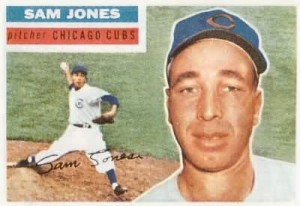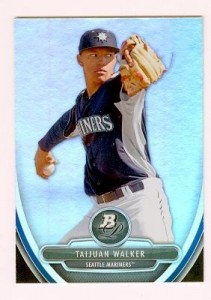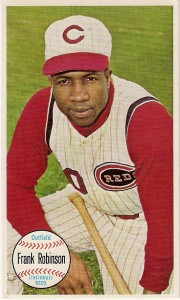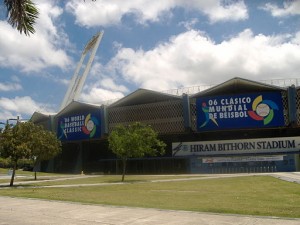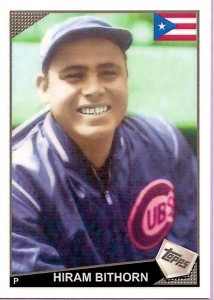Sam “Toothpick” Jones could be intimidating on the mound – not just because of his size (6’4”, 192 pounds), his fastball or his sweeping curve (Stan Musial said Jones had the best curveball he ever saw), but also because he was “effectively wild.” As a Cub in 1955, the tall, lanky right hander led the National League not just in strikeouts, but also in walks and batters hit by pitch. On May 12 of that season, Jones proved just how effectively wild he could be – tossing a no-hitter against the Pittsburgh Pirates in Chicago. Three things about that no-hitter attracted BBRT’s attention:
1) On that day, Jones became the first African-American to throw an MLB no-hitter;
2) It came in what might be considered (statistically) Jone’s worst MLB season (he led the NL in losses, going 14-20); and
3) It had, perhaps, the “wildest” finish ever for an MLB no-no.
Let’s take a look at that historic game’s final inning. First, Jones came into the top of the ninth having notched three strikeouts against four walks. Despite the four free passes, he had faced only one more than the minimum number of hitters (or non-hitters in this case). The Pirates’ number-five hitter, power-hitting first baseman Dale Long, had walked in all three of his plate appearances. Note: In 1956, Long set a still unbroken record by hitting home runs in eight consecutive games. Long’s feat has never been equaled in the National League, but was matched in the AL by Don Mattingly (1987) and Ken Griffey, Jr. (1993). But, back to May 12, 1955. In the second inning, Long was tossed out on an attempted steal; in the fifth he was the lead out in a short-to-second-to first double play; and, in the eighth, he was doubled off first on a line drive to third. The only other Pittsburgh base runner to that point was catcher Toby Atwell, who led off the third with a walk, but was stranded as Jones induced a pop out, strikeout and ground out. Meanwhile, over the first eight innings, the Cubs had scored four runs on fifteen hits off the Pirates’ Nellie King and Vern Law.
So, with a 4-0 lead and the eight, nine and lead-off hitters scheduled to bat, Jones – ironically – seemed in control. That would not last long. Jones started the inning by walking the number-eight hitter, second baseman Gene Freese. The Pirates sent Preston Ward up to hit for pitcher Vern Law and, during the at bat, a Jones’ wild pitch sent Freese to second. The WP didn’t matter much, since Jones went on to walk Ward, bringing up lead-off hitter/center fielder Tom Saffell, still looking for his first hit of the season. Jones walked Saffell to load the bases with no outs.
Coming up? Shortstop Dick Groat (a future batting champion and NL MVP, who would strike out only 26 times in 151 games that season); future Hall of Famer Roberto Clemente (right field); and left fielder/clean-up hitter Frank Thomas. With the bases loaded, and both the no-hitter and game in jeopardy, Cubs manager Stan Hack made a trip to the mound (amid boos from the crowd) with some terse advice “Get the ball over.” After the visit, Jones used just 11 more pitches to strike out Groat (looking), Clemente (swinging) and Thomas (looking).
Note: It’s reported that Cubs’ broadcaster Harry Creighton promised Jones – who pitched with a flat-sided toothpick angling from his mouth – that he would buy him a “gold toothpick” if he threw a no-hitter – and that Creighton spent $11 to make good on his word.
The final inning of Jones historic no-no – three walks and three strikeouts – was pretty indicative of Jones’ pitching style. Jones, would in fact, lead his league in strikeouts and walks in the same season three times – 1955, 56, 58. And, in his two All Star appearances, (1955, 1959) Jones’ line was consistent with the term “effectively wild” – 2 2/3 innings pitched, one hit, one run (unearned), four walks, four strike outs, one hit by pitch.
In all, Jones pitched in MLB in all or parts of 12 seasons (1951-52, 1955-64), taking the mound for the Cleveland Indians, Chicago Cubs, St. Louis Cardinals, Detroit Tigers, San Francisco Giants and Baltimore Orioles. His best season was 1959 (SF Giants) when he tied for the league lead in wins (21-15) and shutouts (4), and led the NL in ERA (2.83). That season, Jones also led the league in walks and finished second to Don Drysdale in strikeouts. Jones finished his MLB career with 102 wins, 101 losses and a 3.59 ERA. In ten minor league season, nine at Triple A, he went 104-66, 3.01. Jones also played in the Negro Leagues (Cleveland Buckeyes), as well as in Panama, Venezuela, the Dominican Republic, and Nicaragua.
Sam “Toothpick” Jones died from cancer in 1971 at age 45
I tween baseball @DavidBBRT
